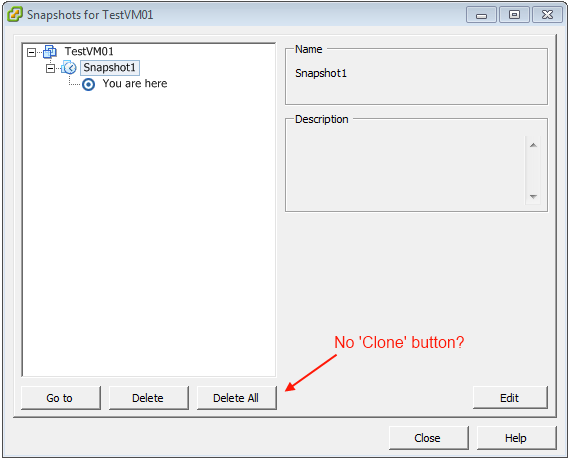Clone a VM from a Snapshot using PowerCLI
A colleague asked me whether it was possible to clone a VM from a particular snapshot. Since there is no capability to do this via the GUI, I looked at what was possible via other means, i.e. PowerCLI.

The vSphere API contains a Clone_VM task, which includes the ability to specify a snapshot to clone from in the VirtualMachineCloneSpec. So I put together the below New-VMFromSnapshot function to make this easy to do for a few different scenarios - it supports multiple snapshots to choose from, full and linked clones, and multiple destinations such as cluster, datastore, VM folder:
- Clone a VM from the current snapshot of VM01, give it a name Clone01, place it in the cluster ‘Test Cluster’ and Datastore01.
New-VMFromSnapshot -SourceVM VM01 -CloneName "Clone01" -Cluster "Test Cluster" -Datastore "Datastore01"
- Same as the above, but this time clone from a snapshot named ‘Testing’ and additionally place it in the Virtual Machine folder “Test Clones” and create only a linked clone rather than a full clone.
New-VMFromSnapshot -SourceVM VM01 -CloneName "Clone01" -SnapshotName "Testing" -Cluster "Test Cluster" -Datastore "Datastore01" -VMFolder "Test Clones" -LinkedClone
Thanks to this post for breaking down a lot of the particulars.
function New-VMFromSnapshot { <# .SYNOPSIS Function to create a clone from a snapshot of a VM.
.DESCRIPTION Function to create a clone from a snapshot of a VM.
.PARAMETER SourceVM VM to clone from.
.PARAMETER CloneName Name of the clone to create
.PARAMETER SnapshotName Name of the snapshot to clone from
.PARAMETER CurrentSnapshot Use the current snapshot instead of a named snapshot
.PARAMETER Cluster Name of the cluster to place the clone in
.PARAMETER Datastore Name of the datastore to place the clone in
.PARAMETER VMFolder Name of the Virtual Machine folder to put the VM in
.PARAMETER LinkedClone Create a linked clone from the snapshot, rather than a full clone
.INPUTS String. System.Management.Automation.PSObject.
.OUTPUTS VMware.Vim.ManagedObjectReference.
.EXAMPLE PS> New-VMFromSnapshot -SourceVM VM01 -CloneName "Clone01" -Cluster "Test Cluster" -Datastore "Datastore01"
.EXAMPLE PS> New-VMFromSnapshot -SourceVM VM01 -CloneName "Clone01" -SnapshotName "Testing" -Cluster "Test Cluster" -Datastore "Datastore01" -VMFolder "Test Clones" -LinkedClone
#> \[CmdletBinding(DefaultParameterSetName=”Current Snapshot”)\]\[OutputType('VMware.Vim.ManagedObjectReference')\]
Param (
\[parameter(Mandatory=$true)\] \[ValidateNotNullOrEmpty()\] \[PSObject\]$SourceVM,
\[parameter(Mandatory=$true)\] \[ValidateNotNullOrEmpty()\] \[String\]$CloneName,
\[parameter(Mandatory=$true,ParameterSetName="Named Snapshot")\] \[ValidateNotNullOrEmpty()\] \[String\]$SnapshotName,
\[parameter(Mandatory=$false)\] \[ValidateNotNullOrEmpty()\] \[String\]$Cluster,
\[parameter(Mandatory=$false)\] \[ValidateNotNullOrEmpty()\] \[String\]$Datastore,
\[parameter(Mandatory=$false)\] \[ValidateNotNullOrEmpty()\] \[String\]$VMFolder,
\[parameter(Mandatory=$false)\] \[ValidateNotNullOrEmpty()\] \[Switch\]$LinkedClone )
\# --- Retrieve snapshot tree using try / catch since if it doesn't exist, an exception is generated function Test-SnapshotExists ($SnapshotQuery) {
try { Write-Verbose "Testing $SnapshotQuery....\`n" $TestSnapshot = Invoke-Expression $SnapshotQuery Write-Output $TestSnapshot }
catch \[Exception\]{
$TestSnapshot = $false Write-Output $TestSnapshot } }
try {
if ($SourceVM.GetType().Name -eq "string"){
try { $SourceVM = Get-VM $SourceVM -ErrorAction Stop } catch \[Exception\]{ Write-Warning "VM $SourceVM does not exist" } }
elseif ($SourceVM -isnot \[VMware.VimAutomation.ViCore.Impl.V1.Inventory.VirtualMachineImpl\]){ Write-Warning "You did not pass a string or a VM object" Return }
\# --- Set values for the Clone Spec if ($PSBoundParameters.ContainsKey('Cluster')){
$DefaultClusterResourcePoolMoRef = (Get-Cluster $Cluster | Get-ResourcePool "Resources").ExtensionData.MoRef }
if ($PSBoundParameters.ContainsKey('Datastore')){
$DatastoreMoRef = (Get-Datastore $Datastore).ExtensionData.MoRef }
if ($PSBoundParameters.ContainsKey('LinkedClone')){
$CloneType = "createNewChildDiskBacking" } else {
$CloneType = "moveAllDiskBackingsAndDisallowSharing" }
if ($PSBoundParameters.ContainsKey('VMFolder')){
try {
$Folder = Get-Folder $VMFolder -Type VM -ErrorAction Stop $CloneFolder = $Folder.ExtensionData.MoRef } catch \[Exception\] {
Write-Warning "VM Folder $VMFolder does not exist, using existing folder instead" $CloneFolder = $SourceVM.ExtensionData.Parent } } else {
$CloneFolder = $SourceVM.ExtensionData.Parent }
\# --- Create CloneSpec and initiate Clone Task switch ($PsCmdlet.ParameterSetName) { "Named Snapshot" {
$Snapshots = @() $SnapshotQuery = '$SourceVM.ExtensionData.Snapshot.RootSnapshotList\[0\]'
while ($Snapshot = Test-SnapshotExists -SnapshotQuery $SnapshotQuery){
$SnapshotQuery += '.ChildSnapshotList\[0\]' $Snapshots += $Snapshot }
$CloneSpec = New-Object Vmware.Vim.VirtualMachineCloneSpec $CloneSpec.Snapshot = ($Snapshots | Where-Object {$\_.Name -eq $SnapshotName}).Snapshot $CloneSpec.Location = New-Object Vmware.Vim.VirtualMachineRelocateSpec $CloneSpec.Location.Pool = $DefaultClusterResourcePoolMoRef $CloneSpec.Location.Datastore = $DatastoreMoRef $CloneSpec.Location.DiskMoveType = \[Vmware.Vim.VirtualMachineRelocateDiskMoveOptions\]::$CloneType
$SourceVM.ExtensionData.CloneVM\_Task($CloneFolder, $CloneName, $CloneSpec) }
"Current Snapshot" {
$CloneSpec = New-Object Vmware.Vim.VirtualMachineCloneSpec $CloneSpec.Snapshot = $SourceVM.ExtensionData.Snapshot.CurrentSnapshot $CloneSpec.Location = New-Object Vmware.Vim.VirtualMachineRelocateSpec $CloneSpec.Location.Pool = $DefaultClusterResourcePoolMoRef $CloneSpec.Location.Datastore = $DatastoreMoRef $CloneSpec.Location.DiskMoveType = \[Vmware.Vim.VirtualMachineRelocateDiskMoveOptions\]::$CloneType
$SourceVM.ExtensionData.CloneVM\_Task($CloneFolder, $CloneName, $CloneSpec) } } } catch \[Exception\]{
throw "Unable to deploy new VM from snapshot" } }